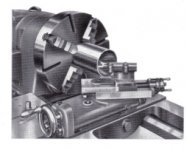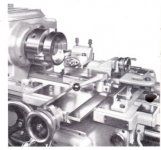Tool rigidity and clearance angles are always an issue with ball turners of the size being considered when dealing with concave radii. Tool has to project at least a little further than the radius and needs enough clearance angle to ensure the heel doesn't ruin what you have just cut.
Things tend to end up unreasonably slender in smaller sizes.
The pivot bar type mentioned by Peter from Holland generally has the best chance at tool rigidity followed by the swivel plate type. But you need to think through the geometry very carefully as its easy to get a different radius than you expect if proper account is not taken of the tool tip offset relative to the pivot.
The Holdrige layout supports the tool pivot from both ends which helps but the body casting is also deceptively sturdy. Most of the pictures on the internet give a false impression of this.
Something to be said for moving over to the Bridgeport and using the head tilt method for generating concave radii.
My up'n over tool is similar to that shown by Jim Rozen with a few refinements of possibly dubious necessity.
Examples of how the professionals did it from the Holbrook Model D accessories list :-
Convex
View attachment 323789, Concave
View attachment 323790, Face profiler for following a template
View attachment 323791
All very heavy (it is Holbrook after all), rigid and accurate. The spherical turning attachment bolts direct to the upper cross-slide (Holbrooks have a second cross-slide below the usual one for taper turning purposes)and face profiler goes between the top and cross-slides. Might be interesting to copy the face profiler system, certainly a rigid way of going about things.
Capacity may be surprisingly limited.
The spherical turner for the D13 (13" swing) and D 15 (15" swing) can handle diameters up to 3" and that for the D18 (18" swing) up to 4 1/2".
The D13 profiler can do depths of 1 1/2", the D15 and D18 versions 2".
When fitted to the high speed plain bearing diamond turning equipped Holbrook C such attachments are were said to be capable of generating surfaces of optical quality in both form and finish. Knowing the plain turning capabilities of diamond turning Holbrooks I'm inclined to believe it.
Clive










